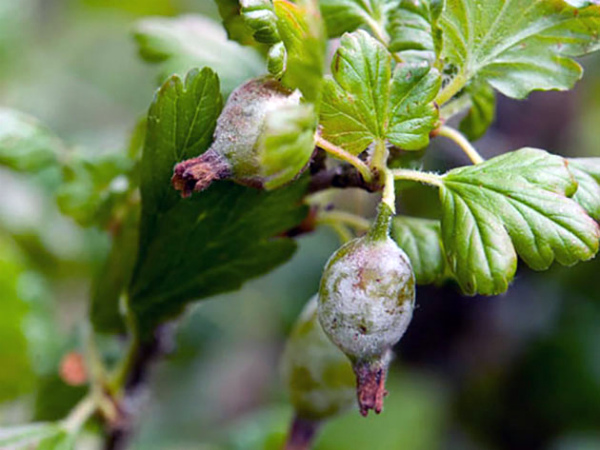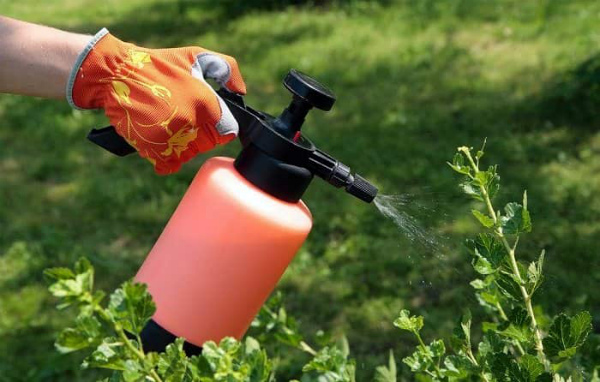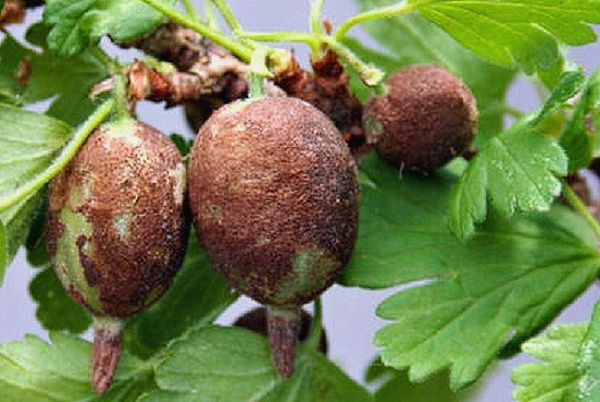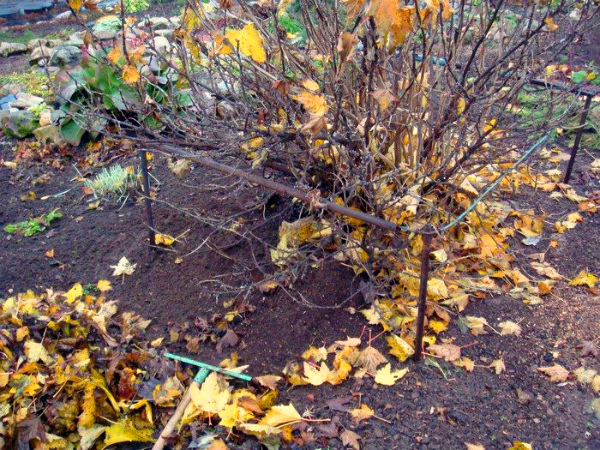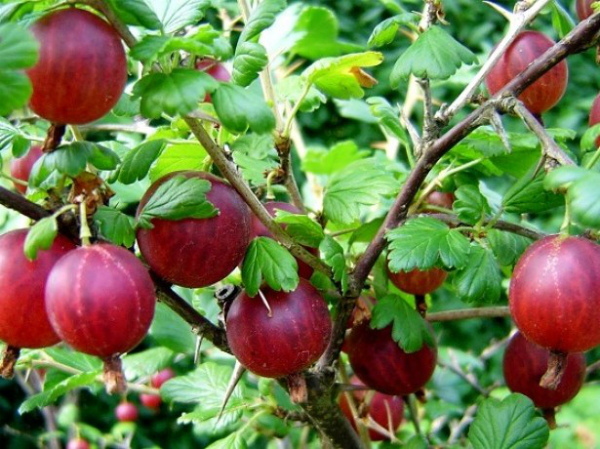Control measures for gooseberry powdery mildew
Content
What's this?
Spheoteca or powdery mildew is a fungal disease that can destroy an adult healthy bush. The smallest spores of the fungus are widely spread by wind or insects, which carry them on their paws. The disease recurs for several years in a row. At first, its appearance contributes to a decrease in yield, then the growth of the plant is inhibited, it withers, in the end, inevitably dies if you do not start the fight in a timely manner.
Powdery mildews settle on young leaves, shoots, flowers, even ovaries and fruits, which develop their mycelium. At first, it looks like a thin cobweb, then it thickens to a white powdery bloom, and when it grows, it turns into a brown felt cocoon, which covered all the affected parts of the plant.
North America is considered the birthplace of the sphere. When the infection came to us at the very beginning of the twentieth century, it immediately caused a lot of harm, spreading very quickly. It parasitizes the plant, bringing it to death. If the stalk is affected, the fruit simply falls to the ground, if the berry itself is affected, it will no longer be able to ripen.
Mushrooms overwinter on fallen berries, on affected branches, and in the spring, when the buds bloom, new spores matured after winter are thrown out. Berries are most vulnerable at the beginning of their development. After the fruit has grown to half its adult size, it becomes more resistant to disease, and so does the whole plant. Therefore, it is important to delay the maturation and release of spores, and this is achieved by the use of fungicides. It is very dangerous to get spores precisely at the beginning of the growing season, when the buds are just blooming, shoots are growing. In a month or two, they won't do as much harm.
Treating the bush in early spring means taking the necessary measures to combat infection. The treated plant will not only tolerate the disease more easily, but also next year it will be less affected by spores.
How to recognize
At the end of May, on young gooseberry leaves, you can often see a delicate white bloom - as if flour were sprinkled on the lower branches of the bush. You need to take this very seriously, consider the whole plant carefully. If spores are found on the leaves and shoots in the form of a white bloom, it means that the plant is already affected by the spheroteca, you need to start fighting immediately. Even if the plaque is easily erased by hand, its amount indicates that the spores have settled on the bush and have already begun to develop the mycelium.
Many have seen a berry covered with a light cobweb or white bloom, or, even worse, a brown crust. You can no longer eat such a berry. If a person examined this plaque under a microscope, it would not have occurred to him to pull these colonies of hairy mushrooms into his mouth.
The disease in its advanced stage looks like a hard brown crust on the berry, like a dark felt cocoon, entangling the entire bush, stunted and withered, with twisted twigs that have stopped growing.
How to fight
The methods of struggle are different, but the fact that it is necessary to urgently take action is undoubtedly. The very first thing to do, if you suspect a powdery mildew infection, is to carefully examine the whole plant, cut off all leaves and shoots on which the slightest traces of a spheroteca are found. The infected parts of the plant must be burned, it is advisable to do this away from the bushes of gooseberries, currants, raspberries, yoshta.
Since the fungus hibernates on fallen leaves and berries under the bush, it is imperative to remove plant debris, dig up the soil around the bush.
Some gardeners advise, on the contrary, to put nightshade tops under the bush, and then water them with EM preparations so that beneficial microorganisms process all the fallen leaves into compost and destroy pathogenic bacteria and organisms.
Every year it is necessary to prune, remove not only old, but all weakened and affected branches. Plant feeding matters - fertilizers make the gooseberries stronger so that they can resist infection. But it is important not to overdo it with nitrogen fertilizers, because they promote the growth of new shoots. The growth of unnecessary branches weakens the plant and expands the area of possible infection, thickens the bush. The fungus loves shade and moisture, too thick bush creates all the conditions for its own defeat.
A good preventive measure is a hot shower for the bush and the ground around it. In early spring, before the buds begin to swell, very hot water is poured onto the bush, about +90 degrees. You can pour it not with clean water, but with a weak solution of potassium permanganate. As a result, most of the causative agents of fungal (along with other) diseases die, by the time new spores grow, the bush will have time to get stronger, bloom or even acquire fruits, and will no longer be so susceptible to it.
The best remedies for processing gooseberries
If you notice signs of infection, if there is even the slightest suspicion of infection with a spheroteca, then you need to fight using all available methods and means. Of course, most gardeners prefer to try folk remedies that will not harm the plant and its fruits. Lactic acid is considered to be very effective in the fight against fungal diseases. You need to take 1 liter of whey (kefir or yogurt), dilute with 9 liters of water and spray the bush three times in three days.
Gooseberries are sprayed with a decoction of field horsetail all season at intervals of one week. And with a decoction of tansy in spring and autumn, they shed the earth around the bushes. Before and after flowering, the bush is treated with a soda-soap solution or a solution of soda ash and soap. Three times (before flowering, after flowering and before the loss of foliage), the bush is sprayed with infusion of onion peel. Three times with an interval of one day at the very beginning of June, gooseberries are sprayed with an infusion of wood ash, and the sediment is poured under the root.
With a frequency of two weeks, the entire season, plants can be treated with such well-known biological products as haupsin and trichodermin. According to the same scheme, a chatterbox of soda, aspirin, liquid soap and vegetable oil is used. After flowering, gooseberries can be treated with ammonium nitrate solution.
All these are very effective methods, more than once tested by a large number of people, but if they do not work, it is worth resorting to special means. "Topaz", "HOM", Bordeaux liquid, a solution of copper sulfate, as well as the joint use of "HOM" with "Fufanon" or "Decis" - these are already stronger drugs, they must be used strictly within the specified time frame, carefully read the instructions before using ...
When choosing gooseberries for your garden, you should pay attention to varieties that are resistant to powdery mildew. By creating thornless varieties, breeders tried to protect them from infection. You should pay attention to the following: "Ural grapes", "Kuibyshevsky" "African", "Grushenka", "Finsky", "Yubileiny" and others.
Video "Getting rid of powdery mildew"
Delicious gooseberry varieties are quite often affected by powdery mildew. This video will tell you about getting rid of the disease.

